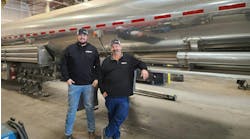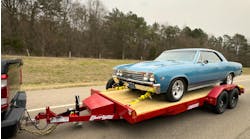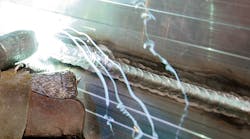In the world of aluminum trailer welding, the effort to improve quality and productivity is never-ending.
Praxair believes it has come up with an enhanced blend called StarGold Aluminum that will do that better than an argon-helium blend.
“Historically there has been some use of argon,” said WF Garth Stapon, automation specialist for Praxair Canada Inc, who was part of the Trailer Forum. “Helium has been in short supply for the past decade—the reason being that the US government considers helium a strategic resource.
“The opportunity here is to try to come up with a gas that can perform like helium without the need to get into supply issues. We are short term in a good position to supply helium, but we have to use it sparingly and ultimately come up with alternatives that can give the client process improvement.
“If you look at the properties of argon vs helium, argon typically is not as good as our customers are demanding. That’s important because productivity, quality, and cleanup can be impacted by the use of argon. The impact of welding productivity can really help to reduce the factors of production costs.”
He said argon and argon-helium blends are typically used for both Gas Tungsten Arc Welding (GTAW) and Gas Metal Arc Welding (GMAW) processes. In GMAW, different bead profiles can be achieved with those gases.
Issues to consider when selecting a shielding gas:
• Weld quality—minimize porosity, inclusions.
• Welding speed.
• Improve metal transfer/arc stability.
• Optimize bead shape and penetration.
Stapon said there is a need for a new aluminum blend to improve aluminum welding performance without the need to add helium. It provides a competitive aspect in Canada because it has better arc stability and a reduced cleaning zone, better weld penetration, and increased welding speed, and currently there are only argon or argon-helium blends in Canada.
He showed a chart that measured arc stability in GMAW. With argon, the average current is 202A, compared to 219A for StarGold Aluminum.
“It’s a much more stable arc,” he said, “and practically speaking, that means we end up with less spatter and cleanup costs.
“We have smaller cleaning zones. With argon, one of the challenges when welding highly thermally conductive materials is that the heat transfer properties of argon are relatively low. We wanted to concentrate the arc with trace amounts of the components to give a more concentrated product and better penetration.
“StarGold Aluminum’s penetration properties are better than pure argon. StarGold Aluminum shows a dramatic improvement in arc stability. Ultimately, the opportunity with this blend is to get lower fill rates, along with the penetration and quality they’re looking for.”
Stapon said that by increasing arc stability, arc energy, and overall arc performance, StarGold can help improve bead appearance and help provide better penetration when welding aluminum alloys including sheet, extrusion, tubing and pipe and other parts.
He said precise blending and consistency comes from Praxair’s mixing process. A master mixture containing a select concentration of the ppm additives is then added at a specific pressure and weight and the cylinders are then pressurized with argon, creating a uniform blend.
Applications where a small cleaning zone and good arc control are desired:
• Truck toolboxes.
• Truck components.
• Fuel tanks.
• Difficult corners.
Overall, he said StarGold Aluminum can help provide benefits for a wide range of applications:
• Automotive frames, hoods, body panels.
• Aluminum truck bodies, trailers, and fuel tanks.
• Livestock and utility trailers.
• Aluminum ship hulls.
• Diamond plate toolboxes.
• Loading ramps.
• Rail car structures and panels.
• Aluminum ladders.
• Radiators and heat transfer equipment.
He said that because StarGold is argon-based, lower gas flow can be used, which can result in cost savings due to less gas and a lower number of cylinders required.
“Welding and labor represents 85% of the total cost,” he said. “The challenge there is that productivity enhancement can be realized. There’s lot of focus put on the cost of materials—the cost of gas, the cost of filler metal. If we can optimize and increase clients’ productivity by 10% to 20%, the overall cost reduction is 8.5% to 17%.”
Zane Michael
Yaskawa American, Motoman Robotic Division
Michael said North America has a huge shortage of welders. The American Welding Society forecasts that by 2026, North America will be about 370,000 welders short.
“As your customers are demanding delivery, quality, and changing the yardstick on what they want, robotics helps them improve their speed to market,” he said. “It’s scalable for small applications, or for large applications. With the price of automation today, it’s easy to achieve a very good ROI. There’s a huge movement in aluminum for lightweight. We’ve been spending a lot of continuous improvements in aluminum welding applications.
“Robotics are very repeatable. You program a robot, regardless of brand it’s going to go to that spot. The challenge we have in manufacturing is, how repeatable is your weld joint?”
He said that when we look at aluminum trailers from a robotics standpoint, we have to look at welding considerations:
• Touch sensing. “It is possible on aluminum, but softer wire may limit search speeds due to bending. Don’t use a wire brake. A pull gun can keep the wire in a constant position.”
• Through arc tracking. “On steel, this is used quite a bit. On aluminum, it is not possible because of the change in current and resistance with the wire. Some manufacturers are working on hybrid signals.”
• Laser sensors. “Generally, it’s the most reliable sensor on aluminum. There is a need to evaluate the surface condition and reflectivity.”
• Fronius. “I am a huge fan of Fronius. They have a push-pull system with the barrel of wire and then a feeder out at the end of the robot.
“So you are pushing and pulling that soft aluminum wire through the feed system out to the torch.”
Jordan Redford
Client service manager
IRCO Automation Inc
Radford went through the different kinds of welding:
• Mechanized welding. Torch or electrode holder carried by a mechanical device. Required manual adjustments in response to visual observation during welding.
• Automated welding. Requires occasional and/or no observation of the weld and no manual adjustments. Function of the welder is to initiate the welding cycle and occasionally check the procedure.
• Robotic welding. Welding executed and controlled by robotic equipment. Welder is to guarantee the weld quality by performing periodic inspections of the results.
He said the keys to successful implementation are having a clearly defined goal, a clearly defined scope, team input, and training.
“What is the reason for considering automation?” he said. “The discovery process involves starting at the arc: understanding the weld process and activities pre- and post-weld.”
He said one of the mechanized welding systems is a welding tractor. It has a cast aluminum body and rigid post design to maximize the CG orientation. The knock-down post design allows for quick setup and disassembly. There are multiple drive configurations for improved torque when pulling long leads and an integrated encoder feedback for precise speed control.









